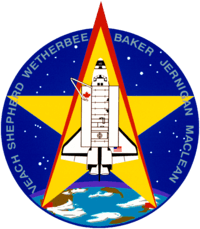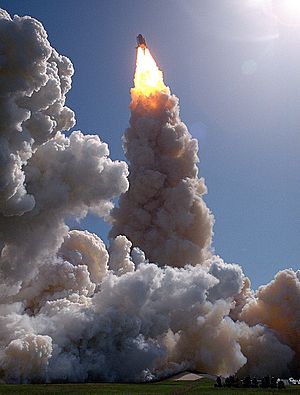STS-52 facts for kids

Columbia's payload bay, with the LAGEOS 2 satellite being deployed.
|
|
| Names | Space Transportation System-51 |
|---|---|
| Mission type | Microgravity research LAGEOS 2 satellite deployment |
| Operator | NASA |
| Mission duration | 9 days, 20 hours, 56 minutes, 13 seconds (achieved) |
| Distance travelled | 6,645,026 km (4,129,028 mi) |
| Orbits completed | 159 |
| Spacecraft properties | |
| Spacecraft | Space Shuttle Columbia |
| Launch mass | 113,460 kg (250,140 lb) |
| Landing mass | 97,574 kg (215,114 lb) |
| Payload mass | 8,078 kg (17,809 lb) |
| Crew | |
| Crew size | 6 |
| Members |
|
| Start of mission | |
| Launch date | 22 October 1992, 17:09:39 UTC |
| Rocket | Space Shuttle Columbia |
| Launch site | Kennedy Space Center, LC-39B |
| Contractor | Rockwell International |
| End of mission | |
| Landing date | 1 November 1992, 14:05:52 UTC |
| Landing site | Kennedy Space Center, SLF Runway 33 |
| Orbital parameters | |
| Reference system | Geocentric orbit |
| Regime | Low Earth orbit |
| Perigee | 300 km (190 mi) |
| Apogee | 302 km (188 mi) |
| Inclination | 28.45° |
| Period | 90.60 minutes |
 STS-52 mission patch  Back: Michael A. Baker, James D. Wetherbee, Steven G. MacLean Front: Charles L. Veach, Tamara E. Jernigan, William M. Shepherd |
|
STS-52 was a NASA Space Shuttle mission using the Space Shuttle Columbia. It launched on October 22, 1992. This mission focused on scientific research in space. It also deployed an important satellite.
Contents
Meet the Astronauts
The STS-52 mission had a crew of six brave astronauts. They worked together to complete all the tasks in space.
Main Crew Members
| Position | Astronaut | |
|---|---|---|
| Commander | James D. Wetherbee Second spaceflight |
|
| Pilot | Michael A. Baker Second spaceflight |
|
| Mission Specialist 1 | Charles L. Veach Second and last spaceflight |
|
| Mission Specialist 2 | William M. Shepherd Third spaceflight |
|
| Mission Specialist 3 | Tamara E. Jernigan Second spaceflight |
|
| Payload Specialist 1 | Steven G. MacLean, CSA First spaceflight |
|
Backup Crew Members
Sometimes, astronauts have backup crew members. They train in case a main crew member cannot fly.
| Position | Astronaut | |
|---|---|---|
| Payload Specialist 1 | Bjarni Tryggvason, CSA First spaceflight |
|
Mission Goals and Experiments
The main goals of STS-52 were to launch a special satellite and to do experiments in microgravity. Microgravity means a very low gravity environment, like what astronauts experience in space.
Launching the LAGEOS-2 Satellite
One key task was deploying the Laser Geodynamics Satellite 2, or LAGEOS-2. This satellite was a joint project between NASA and the Italian Space Agency (ASI). It was released from Columbia on the second day of the mission. LAGEOS-2 helps scientists study Earth's shape and gravity. It also helps track how continents move.
Microgravity Research with USMP-1
The mission also included the U.S. Microgravity Payload-1 (USMP-1). This set of experiments studied how different materials behave in space. These experiments were placed in the shuttle's cargo bay.
- Lambda Point Experiment: This experiment studied how fluids behave at very cold temperatures.
- MEPHISTO: This experiment, from France, looked at how metals solidify in space.
- Space Acceleration Measurement System (SAMS): This system measured tiny vibrations on the shuttle. These vibrations can affect sensitive experiments.
Other Science Projects
Many other experiments were carried out during STS-52.
- CANEX-2: This Canadian experiment package included several smaller projects.
- Space Vision System (SVS): This system helped astronauts see and control robotic arms better.
- Materials Exposure in Low-Earth Orbit (MELEO): This exposed materials to the harsh space environment.
- Queen's University Experiment in Liquid-Metal Diffusion (QUELD): This studied how metals mix in space.
- Phase Partitioning in Liquids (PARLIQ): This looked at how liquids separate.
- Sun Photospectrometre Earth Atmosphere Measurement-2 (SPEAM-2): This measured sunlight passing through Earth's atmosphere.
- Orbiter Glow-2 (OGLOW-2): This studied a faint glow around the shuttle caused by atoms in space.
- Space Adaptation Tests and Observations (SATO): This observed how astronauts adapted to space.
- ASP: This set of sensors tested new ways to help the shuttle know its position in space.
- Middeck Payloads: Several smaller experiments were done inside the shuttle's cabin.
- Commercial Materials Dispersion Apparatus Instrument Technology Associates Experiments: These looked at how different materials mix.
- Commercial Protein Crystal Growth experiment: This grew protein crystals, which helps in making new medicines.
- Chemical Vapor Transport Experiment Heat Pipe Performance Experiment (CVTEHPPE): This studied how heat moves in space.
- Physiological Systems Experiment (PSE): This involved studying small rodents to see how living things adapt to space.
- Shuttle Plume Impingement Experiment (SPIE): This studied how the shuttle's engine exhaust affected other objects.
A Special Passenger
A small amount of the ashes of Gene Roddenberry were carried on this mission. He was the creator of the famous TV show Star Trek.
Wake-Up Music
Since the Project Gemini missions, NASA has had a tradition of playing music to wake up astronauts. A special song is chosen each day. Often, the astronauts' families pick the songs. These songs might have a special meaning or relate to the day's activities.
| Day | Song | Artist/Composer | Played For |
|---|---|---|---|
| Day 2 | Wake Up Columbia | Crow Carroll | |
| Day 3 | Shake, Rattle and Roll | Big Joe Turner | Deployment of LAGEOS-II |
| Day 5 | The World is Waiting for the Sunrise | Les Paul and Mary Ford | |
| Day 6 | Birthday | The Beatles | Mike Baker's 39th Birthday |
| Day 7 | "Hawaiian music" | ||
| Day 8 | Mack the Knife | Bobby Darin | |
| Day 9 | Bang the Drum | Todd Rundgren | |
| Day 10 | Monster Mash | Bobby "Boris" Picket | To celebrate Halloween |
| Day 11 | Notre Dame Victory March | JSC employees & Notre Dame grads | James Wetherbee |


